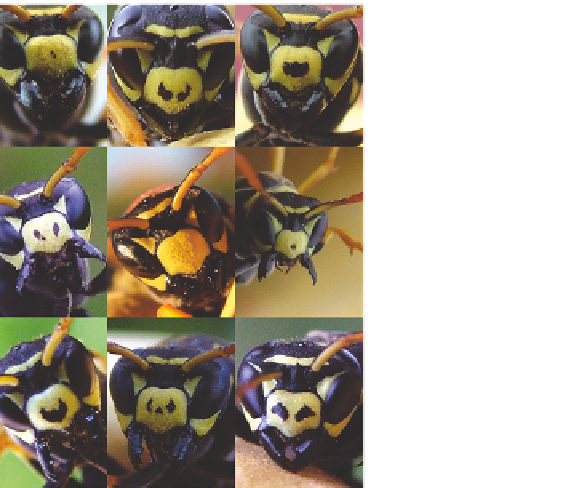Biology Reference
In-Depth Information
CHAPTER 14
Communication
and Signals
Photos © Elizabeth Tibbetts
Most of the interactions between individuals described in this topic involve
communication. Males attract females with showy ornaments or repel rivals with loud
roars, offspring beg from their parents, bacteria release chemicals to coordinate
cooperative behaviours at the population level and poisonous caterpillars warn their
predators away with bright colours. All of these cases involve the use of special
signals
or
displays
that appear to have been designed for use in communication. This chapter is
about how natural selection shapes signals.
The most obvious characteristic of a signal is that it is a feature of one individual
(sender) that in some way modifies the behaviour of another (receiver). The receiver's
response may be immediate and obvious (a male firefly rapidly flies towards a flashing
female of the correct species); it may be subtle and difficult to detect (a male antelope
slightly alters its direction of walking to avoid crossing a territorial boundary when it
detects the scent marks of a resident); it may be delayed in time (the ovaries of a female
budgerigar gradually develop as the result of the stimulus of male song); or it may not
occur all the time (a territorial male blackbird sings for several hours during which time
only one or two intruders hear the song and retreat).
It used to be assumed that signals evolved for the efficient transfer of information
between sender and receiver. Dawkins and Krebs (1978; Krebs & Dawkins, 1984)
pointed out that this idea will usually be incorrect, because when there is a conflict of
interest between sender and receiver, each will be selected to pursue their own selfish
interests. This led to them developing a more antagonistic idea that communication is
an arms race between senders trying to manipulate receivers, and receivers mind-
reading senders. However, whilst there will often be a conflict of interest between sender
and receiver, it is also true that if natural selection cannot lead to a situation where, on
average, both parties benefit from the exchange, then the signalling system would not
be stable (Maynard Smith & Harper, 2003). If senders manipulated receivers too well,
then receivers would be selected to ignore senders. So, signals must carry information
Communication
involves a sender
and a receiver
Signals will only
be evolutionarily
stable if, on
average, both
sender and
receiver benefit
from the
signalling system





























